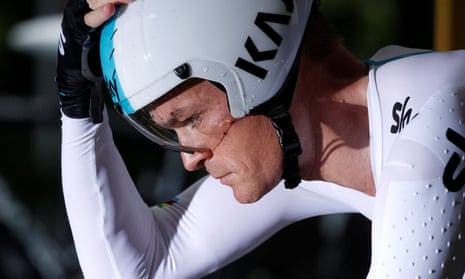Team Sky are no strangers to controversy but the turbulence around their use of the Vortex skin suit, with its panels that enhance airflow past the arms and shoulders, is something they should embrace. There should be no hesitation in criticising Sky when it comes to jiffy bags and triamcinolone but in this particular area, they appear to be in the right and they are doing precisely what they – and all teams that have the resources and backing to so do – should be doing: pushing the boundaries of what is permitted within the rules. If that prompts debate, so much the better.
The Vortex story is familiar to anyone who has studied the British Cycling secret squirrels: find something that offers an aerodynamic advantage, test it quietly in a race, run it discreetly past the authorities to make sure they won’t stop you using it and wheel it out for the big occasion when it will offer the greatest advantage and will discomfit your rivals. That process was repeated time and again by the British Olympic team in the run-in to Beijing, London and Rio. It is sufficiently well known and documented that any other team can do it, and would be foolish not to do it.
Since their inception, Team Sky have pushed the boundaries of what the sport permits. Some of the areas they have ventured into are now common currency: aerodynamic racing kit in general – oversocks, skinsuits, panelled jerseys, filled in helmets, smoothed out bikes – warming up on static rollers or turbo trainers before races, warming down. Go to any amateur race nowadays and everyone is using aero kit and warming up intensely before they race - that is how far it has filtered down in the last few years.
None of this is novel. Teams have pushed out into aerodynamics in varying degrees since Gitane’s Profil bike in 1979 – which was saved up for the Tour in exactly the same way that Sky waited with the Vortex – and every aerodynamic step forward has created debate, and, yes, controversy. Just look back to Greg LeMond’s use of triathlon bars in 1989, and Francesco Moser’s disc wheels in 1984. Team Sky haven’t invented marginal gains, but what they have done is to actively and publicly embrace them.
Some of the things Team Sky have tried haven’t worked. The closed in area for warming up before time trials they worked on in 2010 was unpopular from day one, as it went against one of the sport’s USPs – its accessibility to the public. The attempt to take riders out of hotels and put them into luxury motorhomes was another, the problem being that if every team ended up doing this, the space a given race would require would become absurd. But they have every right to try legal means of improving performance, and if more teams did so the sport would be more colourful, more interesting, more high-profile.
What is different with Team Sky is the relentlessness of their pursuit of improvement, the level of hype and the debate they incite. That’s partly because they have historically had no hesitation in saying that this is what they do, which goes against cycling tradition. Their rivals have every right to question whether the Vortex is within the rules - that too is part of the gamesmanship. It would, however, have been a surprise if the skin suit were not legal, simply because no team wants to risk having its kit banned at the last minute on race day.
One reason we can, and should, enjoy the debate is this: one of the joys of cycling – compared in particular to Formula One – is that the purely technical side of it is unlikely ever to be more important than the “driver” and the “engine”, the cyclist and his body. Technology in cycling can enhance performance but is unlikely to define it to the extent it can in motor sport.
One final note. In 20 days’ time when the Tour field takes on the time trial in Marseille, look closely at the kit worn by the riders, particularly those sponsored by cutting-edge kit manufacturers. Some are almost bound to be using skin suits with panels like those worn by Sky in Düsseldorf, having rushed them through production since the start of the Tour. If not, teams will be using them before the end of the year. Imitation, as we all know, is the best kind of flattery.

Comments (…)
Sign in or create your Guardian account to join the discussion